Today we are looking at the Dell OptiPlex 7080 Micro as part of our Project TinyMiniMicro series. This is Dell’s 10th gen Intel Core ~1L corporate desktop PC that is designed to provide a solid computing experience in a relatively small chassis. We are in the process of taking a look at these 10th Generation Intel Core systems to give some sense around how much the segment has progressed over the five generations we have tested. The Dell OptiPlex 7080 is a premium line that sits above the 3080 and 5080 which means we have more features to look at in this review.
Project TinyMiniMicro Background
In Project TinyMiniMicro we are purchasing a large number of these devices from different sources. While a standard STH review is of a new product, these TMM nodes occasionally have specs that differ from what one would expect. In all of these pieces, we are going to talk about what makes the nodes unique. We are now well over 35 different nodes to increase diversity. We are testing these on a more circular economy/ extended lifecycle basis to see how they can be deployed after their initial use as corporate desktops. As always, we have a video version of this article.
We recommend opening this video in a YouTube tab/ app for a better viewing experience.
For our $625 (before tax), we received a node with an Intel Core i5-10500T, 8GB of memory, WiFi 6, and a 256GB NVMe SSD. We even got an embedded Windows 10 Pro license which would have cost us around $140 alone. Something that was a bit different is that we had a 3-year on-site warranty with this unit.
This is part of our new series where we are taking a look at some of the newest 10th generation ~1L PCs on the market. With our TinyMiniMicro series, we understand that there is always going to be tension. Older units are less expensive, but unlike buying an old hammer, we get significantly more capabilities and features in new versions. So we wanted to update Project TinyMiniMicro to see if newer units justify the price premium over older ones.
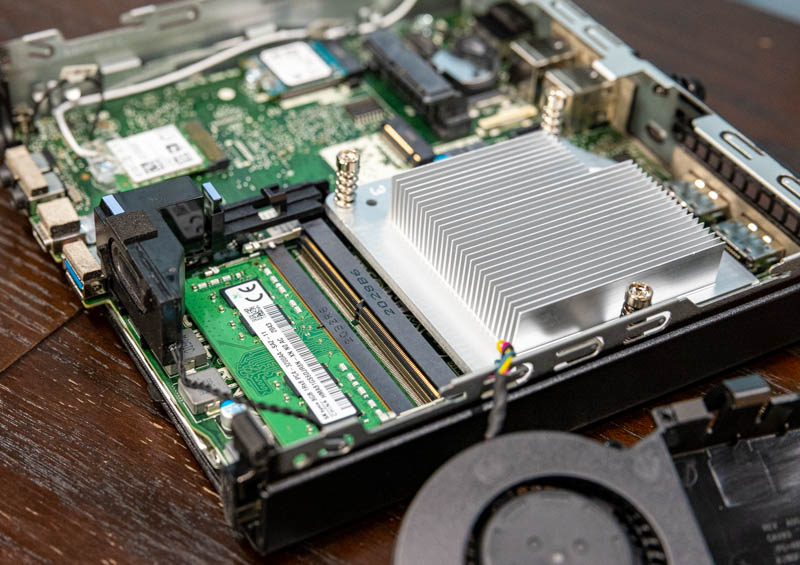
In this generation, we already reviewed the Lenovo ThinkCentre M75q Gen2 Tiny and ThinkCentre M90q Tiny. In terms of market segment, the OptiPlex 7080 Micro is most similar to the M90q Tiny and the HP Elite Desk 800 G6 (35W and 65W) that we will be looking at soon on STH. Perhaps this is more of the premium 1L desktop segment although some of the changes are relatively small.
We are going to go into a quick hardware overview, then into the key specs. We are then going to talk a bit about performance and power consumption before getting to our lessons learned from these units and our final words.
Dell OptiPlex 7080 Micro Hardware Overview
The Dell OptiPlex 7080 Micro is around 1L in size and uses an updated front design compared to the Dell OptiPlex 7070 Micro and OptiPlex 7060 Micro we reviewed previously.
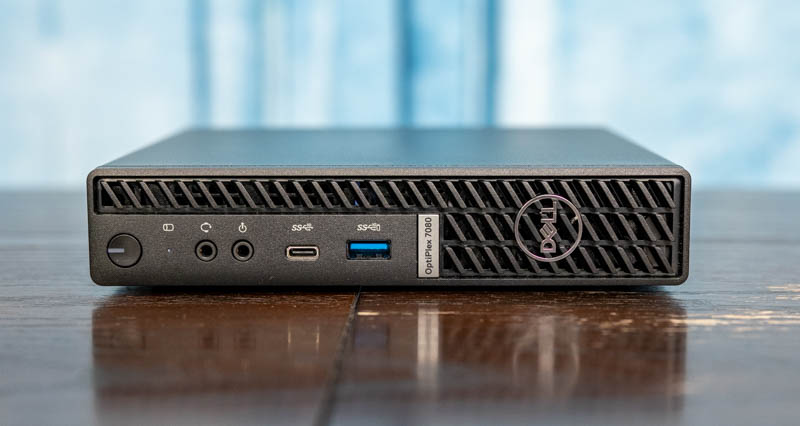
Aside from the power button, we get a headset port on the front of the system. One more unique feature is that we get a line-out jack as well. We also get a USB 3.2 Gen2 Type-A port and a USB 3.2 Gen2 Type-C port on the front. Some units have three front USB ports, but this is a good combination with both being 10Gbps Gen2 ports and having both Type-A and Type-C.
On the rear of the unit, we get a fairly standard port configuration. We get two DisplayPort outputs. Some competitive systems have HDMI and DisplayPort which we probably like better for connecting without an adapter to televisions. We get two USB 3.2 Gen2 and two Gen1 Type-A ports for four total. Dell has an optional slot that one can configure as blank, or get various serial or display outputs. We did not get anything configured in this port. We will note the rear of the units with PCIe GPUs has a different layout in order to accommodate those GPUs.
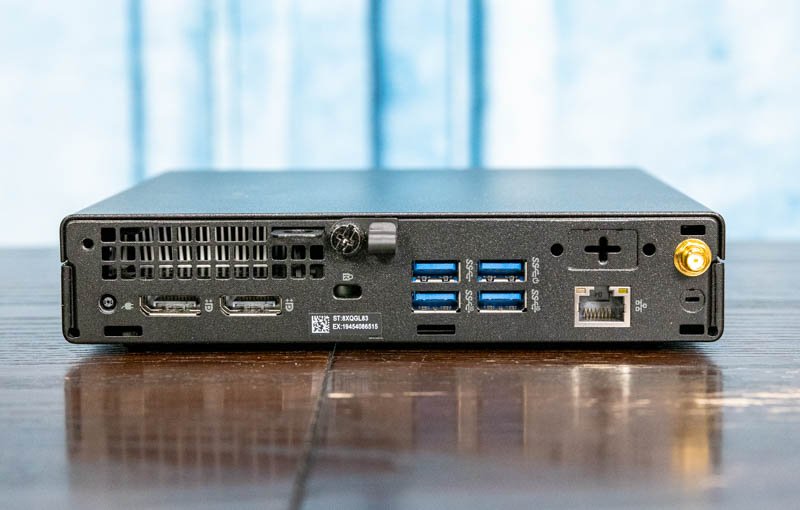
Networking is provided by a RJ45 connector. This is an Intel i219-LM NIC which is important. This configuration is valid for Intel vPro so we need to use this NIC. Frankly, given we are seeing on the Intel NUC 11 Pro Review Tiger Canyon NUC11TNKi5 and other systems 2.5GbE, this does feel a bit old even as the current generation since we are in the middle of an update to 2.5GbE in the desktop industry. We also just reviewed a lower-cost TRENDnet TEG-S380 8-port 2.5GbE switch so the 2.5GbE ecosystem is picking up. Hopefully, we will see this upgraded in future models.
The cover removes with a single screw. We like that Dell makes this easier than Lenovo, but there is another feature. The cable retention clip that is attached to the chassis screw has a neat resting place on the chassis so it can swivel around the screw when needed or be secured in the chassis. This is a very small feature, but one that we appreciated after reviewing around three dozen units in this ~1L PC space.
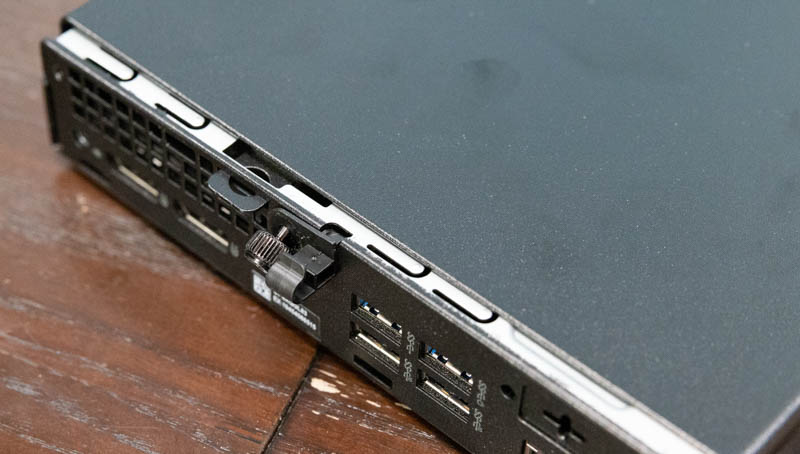
Inside we have a fairly typical Dell Micro layout. The CPU and memory are on top with the storage on the bottom. Our unit came with the blue 2.5″ hard drive/ SSD tray. This is a tool-less solution that one can use to install a SATA drive into the system.
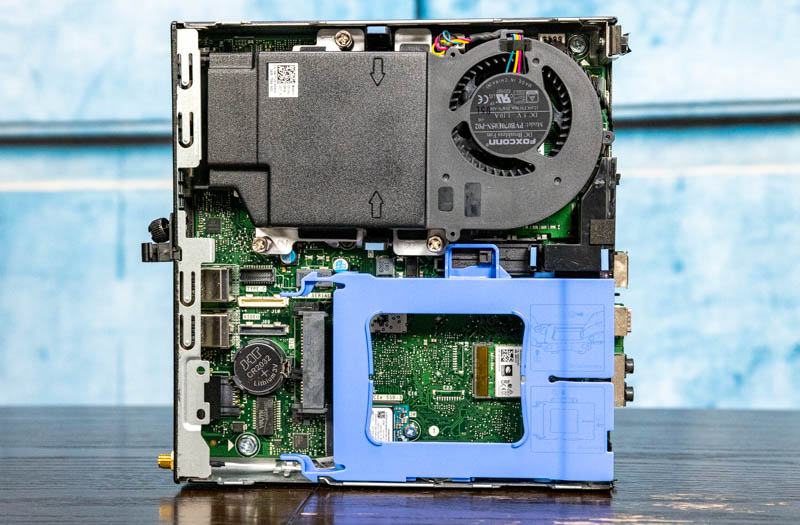
The SATA drive connects to a hard-mounted SATA data and power connector which is a significant upgrade over the HP and Lenovo units that use proprietary cables.
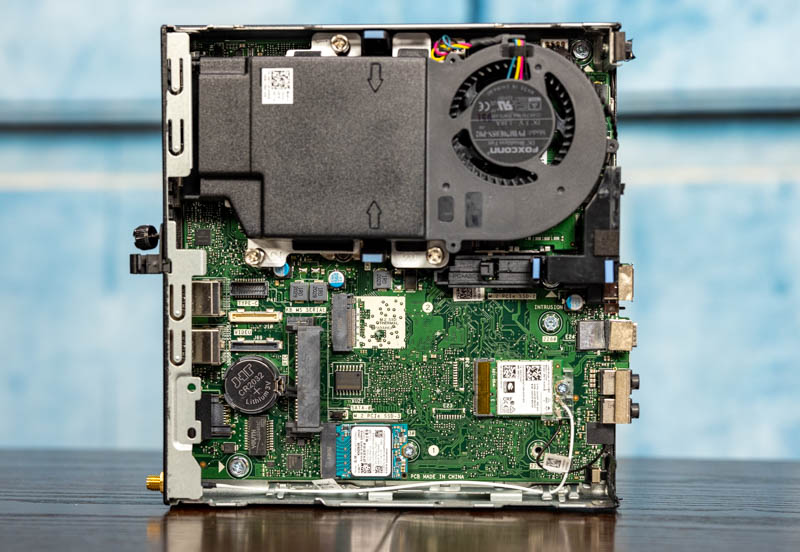
In this system, we had the WiFi option, specifically with the Intel AX201 WiFi 6 and Bluetooth 5.1 connectivity. WiFi is optional, and Dell has options for lower-speed Qualcomm radios, but our advice is to get the Intel AX201 solution installed from the factory. It is much easier than adding this later.
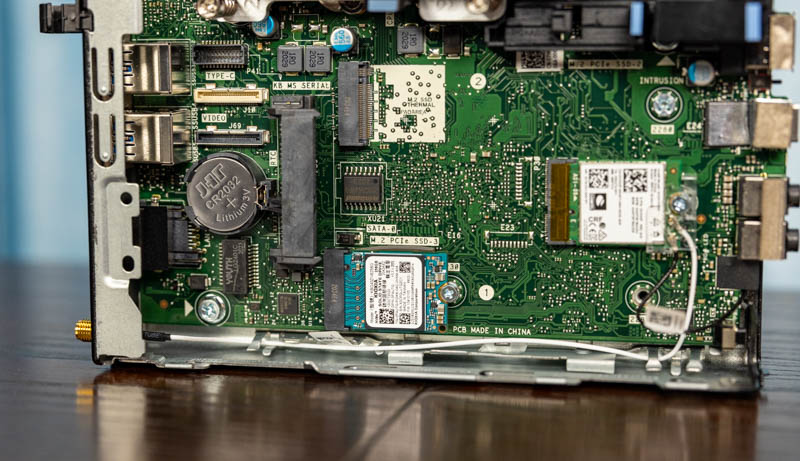
On either side of that WiFi module, there are two M.2 SSD slots. Our unit had a 256GB Kioxia BG4 NVMe SSD installed. Dell usually calls this a Class 35 option and it is a DRAM-less SSD. It is inexpensive and lower power, but if you want higher performance or capacity, there are other options.
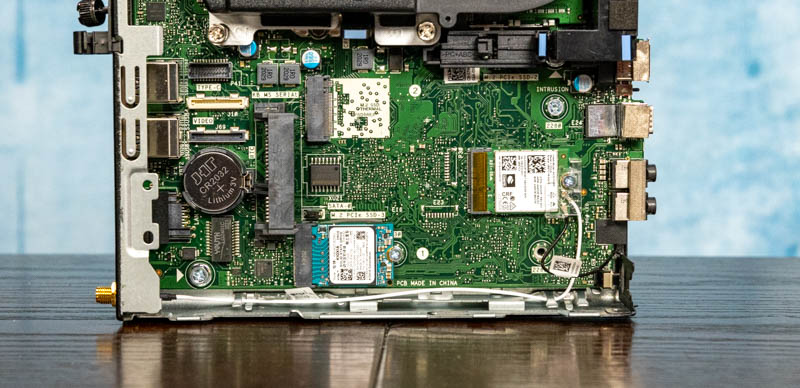
Since we did not have optional rear I/O, the internal I/O headers are present, but not used.
Under the top fan and shroud, we have memory and the CPU. Memory can be up to DDR4-2933 in this generation. We tried this with DDR4-3200 and the speed was set to DDR4-2666. That is due to the fact that only the Core i7/i9 in this generation support DDR4-2933. The Core i5 we have supports DDR4-2666 only. We have this system with only 8GB of memory but we would suggest getting more memory and using two SODIMMs for dual-channel operation in this system. Despite what Apple does with its M1 Macs, 8GB is still very low for a modern system in this class. A benefit is that upgrading to 32GB can be done for under $150 here and does not require tools. Apple charges a $200-300 premium to go from 8GB to 16GB in the M1 Macs. Note we have two 8GB Mac Mini M1’s and a 16GB M1 in the lab and a new M1 16GB with 10GbE inbound so the performance and price of those solutions we are well aware of. An advantage here is the ability to upgrade because at some point one just needs more RAM.

Paired with the Intel Q470 chipset we have an Intel Core i5-10500T. This is a 6 core/ 12 thread processor which effectively adds Hyper-Threading to this segment. This is a 35W TDP CPU unit, but Dell offers versions with 65W TDP CPUs that we expect have more robust cooling.
Overall, this solution is easy to upgrade and service, but it also feels very similar to many of the systems in this line.
Next, we are going to take a look at the key specs, and performance before getting to our power consumption and final words.

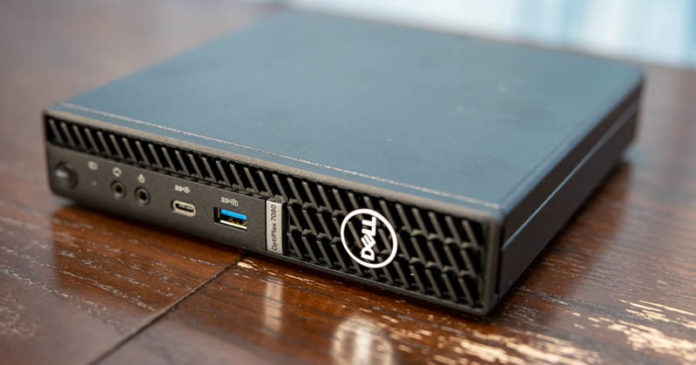
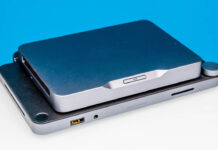
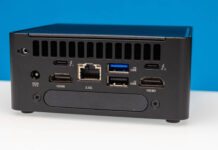

You compare it a lot with the NUC so instead you should be reviewing the optiple and 7090 ultra which is more like a NUC
Did you guys install ubuntu 18.04 or something more recent? I had to walk back on an itx build because the igpu support for uhd630 is broken on the recent *buntus
Thank you Patrick for a great review of DELL’s minimicro re-fresh.
Thank you for another great review, could you also consider looking at Dell Precision 3240 compact, from what I can see it looks like 2 of these units stacked together. It would be interesting to see if that unit is any better with a 65watt CPU
Optiplex 7080 with onboard graphics is poop as it doesn’t support a third display…
the intel cpu onboard won’t cut it as the shared memmory is not big enought, if you ordered the i7 model it would be enought for 2K Display as daisychained of two and another one so three in total..
the i5 1055T whatever does not have enought power :-/
Is there a serial port add-on option (not a PCIE card, but similar to the link copied below) for the 7080 Micro? Or one made for any of the 3000/5000/7000 series that is compatible with the 7080 Micro? https://www.dell.com/en-us/shop/dell-additional-hdmi-video-port-for-3060-5060-7060-micro/apd/325-bddz/pc-accessories
I have got one of these and want to upgrade the storage. Dell site says it can either support 1 NVMe, 2 NVMe, or 1 SATA with Optane. Has anyone with 7080Micro successfully used 3 SSDs i.e. 2 M.2 NVME and 1 SATA SSD together?